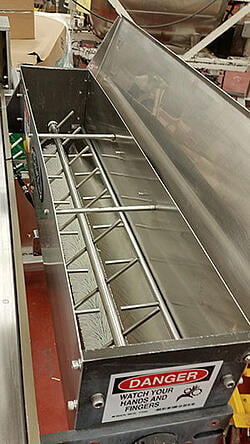Getting employees to follow the rules, even rules that keep them safe, is difficult. For some segments of the population is seems impossible. Everyone knows, for example, that talking on a cell phone while driving is dangerous, and against the law in most states. But a large percentage of the population continue to talk on a handheld phone while driving anyway. This is even more true of texting and driving. And accidents and deaths continue.

This same lack of respect for safety and safety rules is pervasive in many work places. The National Safety Council tells us that 89% of workers ignore some, or all, safety rules. So simply having a rule, or posting a sign that says “Keep your hands off this dangerous thing” is unlikely to be a foolproof method of keeping employees safe during operations in their plant. It’s because of human nature that machine guarding is necessary. Too many people need to be protected from their own bad behavior and lack of respect for safety and rules around moving machinery. Many facilities managers put up signs and send around memos. Don’t do this or don’t do that, but employees do it anyway.

And alternative, and supplement to rules is designing protective systems to protect people from themselves. In the industrial work setting this can include many types of safety systems including light curtains, electrical interlocks and machine guarding. Machines guards are often the most practical and often don’t need to be sophisticated or expensive. Effective guards can prevent many accidents. One tool to help design machine guards is the Gotcha Stick. The Gotcha Stick is a simple, low tech device that measures the distance of barriers from pinch points and other moving parts in a machinery. If the barriers are at the right distance to keep people from reaching in and messing with the machinery, then they’ll pass the Gotcha Stick test and keep machine operators from getting hurt. Applying the rules of human nature we can say that it’s generally easier to change people’s environments than to change people. If you really don’t want people to touch something you can erect a barrier and test it with the Gotcha Stick. Extend that lesson across the facility. If you don’t want people opening the cabinet to do things to the component, make the cabinet hard to open. If you don’t want people to change the settings on a control panel, make the changing of settings require a password that’s hard to come by.
Omron was the “inventor” of the Gotcha Stick and the first to introduce it as a safe distance scale. Although not officially adopted by OSHA, the Gotcha Stick is based on data from “A Review of Machine-Guarding Recommendations,” by Donald R. Vaillancourt and Stover H. Snook of the Liberty Mutual Research Center for Health & Safety. This data defines the dimensions of the human arm and hand for the purposes of machine guarding. It tests the allowable barrier opening size based on the distance from the point of operation and verifies that openings in guarding will not allow the pinch point or moving part to be accessed by the operator.
A simple example of the use of the Gotcha Stick is shown in the two illustrations. The device is a crumb catcher used at a bakery for collecting crumbs from a bake goods line. There was a guard on it with lots of signs saying danger and keep your hands out. But human nature was to think people could put their hands in if they are very careful, in spite of the signs. And employees did put their hands in the crumb catcher and their hands pinched in between the bars. In addition to human pain, these accidents cost money. So, this needed to be prevented. It was time for a machine assessment. The owner of the machine called Re:Build Optimation who sent in a safety technician to do a safety assessment. Among other tools he used a Gotcha Stick. Based on the pinch point, which was six inches down, the Gotcha stick recommended a 5/8 inch gap. You can see the revised guard in the second second picture. And after the change in guarding no one could get their fingers in close enough to get them pinched. No more Gotcha!


We all know that even when employees make poor choices and fail to follow training and rules, the liability may fall on the employer. This means that machines and processes must be designed or redesigned to minimize any chance of injury. At Re:Build Optimation we employee safety engineers, safety technicians and others who can help design safe and fault tolerant systems for manufacturing plants. They know how to use the Gotcha Stick and it is one of many tools in their kit to design and implement safer work places for manufacturers.
Looking to connect with an experienced team?
Look no further than Re:Build Optimation! We are excited to connect with you.